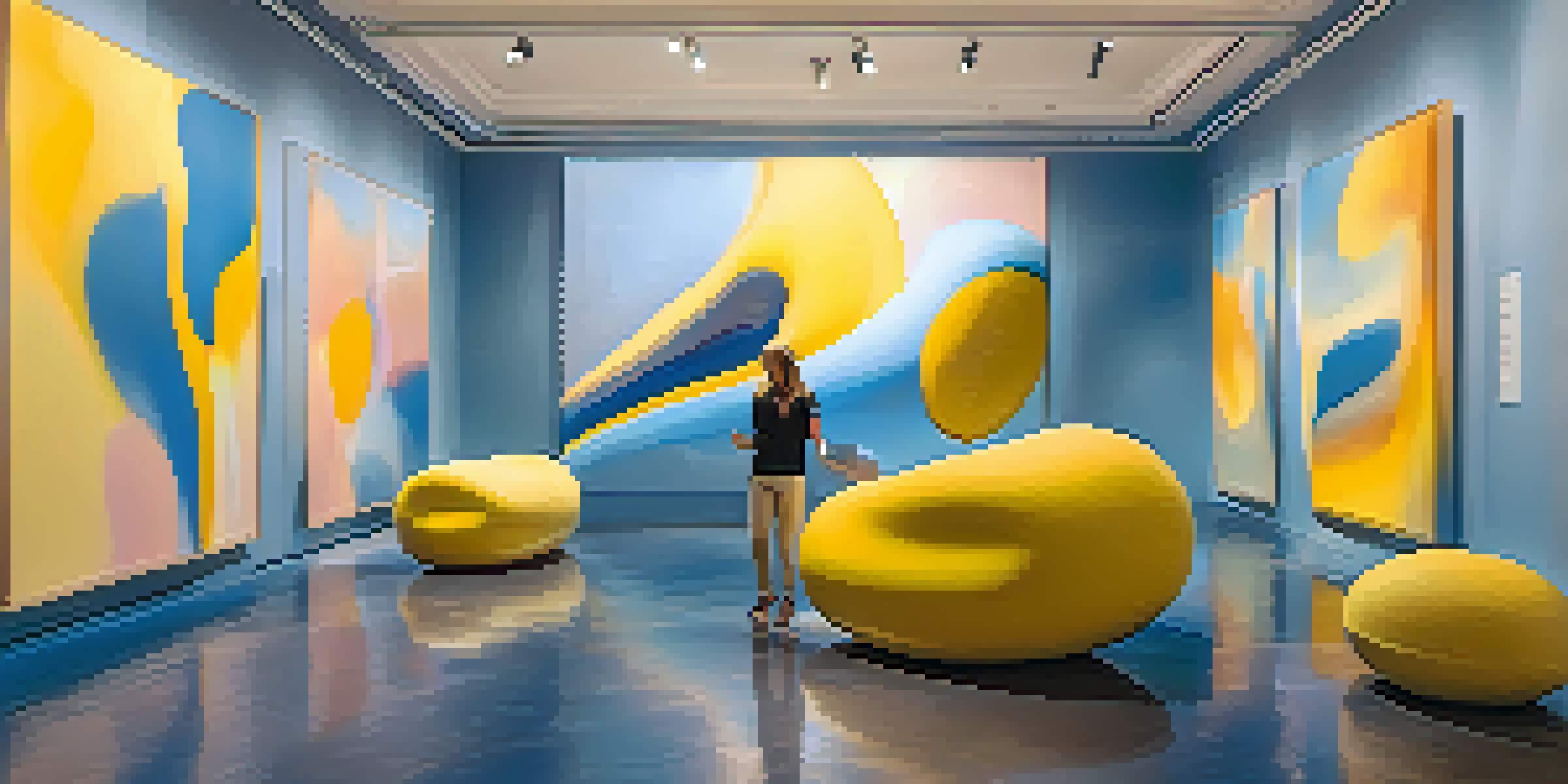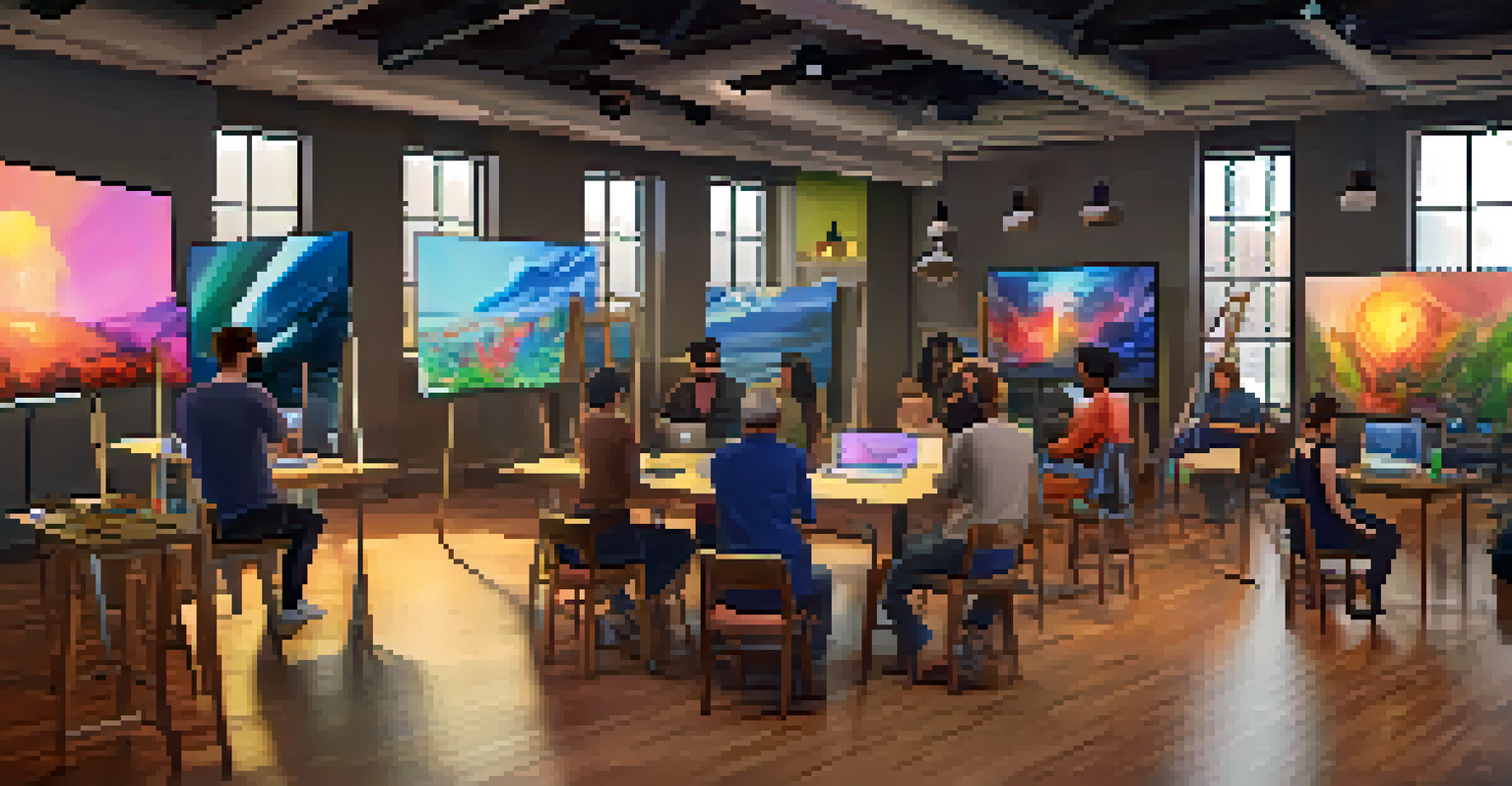Virtual Reality in Art: Immersive Experiences in Painting

Understanding Virtual Reality in the Art World
Virtual reality, or VR, is a technology that immerses users in a digitally created environment. In the art world, this means artists and viewers can enter spaces that are not limited by physical constraints. Imagine walking through a painting or interacting with 3D sculptures that change as you move; this is the magic of VR in art.
Art is not what you see, but what you make others see.
Artists can create experiences that are not just visual but also tactile and auditory, engaging multiple senses. This level of immersion allows for a deeper connection with the artwork, making the experience more memorable. It’s like stepping into a story where you become a part of the narrative, rather than just an observer.
As VR technology continues to evolve, it opens new doors for creativity and expression in art. Artists are now experimenting with virtual canvases, where they can paint in three dimensions. The possibilities are limitless, and this innovation is reshaping how we view and experience art.
The Evolution of Painting Through Virtual Reality
Painting has historically been a flat medium, confined to canvases and surfaces. However, with the advent of VR, artists can now expand their work into three-dimensional spaces. This transformation resembles moving from a book to a full cinematic experience, where the viewer can walk around and explore details in new ways.

VR tools like Tilt Brush allow artists to paint in 3D space, creating environments that envelop the viewer. Imagine swirling colors and shapes around you, almost like a dance of light and form. This not only enhances creativity but also changes how viewers interact with the artwork, as they can control their perspective.
VR Transforms Art Experiences
Virtual reality immerses users in art, allowing for interactive and multi-sensory experiences that deepen emotional connections.
The evolution of painting through VR helps to break down traditional barriers while inviting a broader audience to engage with art. This technology democratizes the art experience, allowing anyone with a headset to enter these imaginative worlds, transforming the art scene into an inclusive space.
Immersive Experiences: Engaging the Senses
Immersive experiences in VR painting go beyond visuals; they engage all the senses. Artists can incorporate soundscapes that resonate with the artwork, creating an emotional backdrop. For example, a serene landscape might be accompanied by soft rustling leaves or gentle water sounds, enhancing the viewer's experience.
The future belongs to those who believe in the beauty of their dreams.
When viewers step into a VR painting, they are not just looking; they are feeling and hearing, which adds layers to their understanding. This sensory engagement can evoke stronger emotional responses, helping people connect with art on a personal level. It's as if the artwork speaks to them, drawing them into its world.
By merging visual art with sound and even haptic feedback, VR offers a more holistic artistic experience. This innovative approach to art challenges the traditional notion of passive viewing and invites active participation, making each encounter unique.
Creating Art Communities in Virtual Reality
VR also fosters community among artists and art lovers, transcending geographical boundaries. Virtual galleries and exhibitions allow people from around the world to come together, share ideas, and appreciate art in real-time. This sense of belonging can be incredibly empowering for artists who may feel isolated in their creative journeys.
In virtual spaces, artists can collaborate on projects, host workshops, or even hold live painting events. Picture a global gathering where artists demonstrate their techniques, and participants can ask questions and interact. This communal aspect not only enhances learning but also builds relationships within the artistic community.
Community Building in VR Art
VR fosters global art communities, enabling collaboration and shared experiences beyond geographical limits.
Moreover, these virtual communities can democratize access to art, allowing people from various backgrounds to engage with and contribute to the art world. It’s a refreshing shift that encourages diversity and inclusivity, ultimately enriching the entire artistic landscape.
Challenges and Limitations of VR in Art
While the potential of VR in art is immense, there are challenges that artists and institutions face. The technology can be expensive and may require significant investment in hardware and software. Not all artists have access to the tools needed to create immersive experiences, which can limit participation.
Additionally, there can be a learning curve associated with understanding and mastering VR tools. Artists used to traditional methods might find it daunting to transition to digital platforms. This shift requires not only technical skill but also a willingness to experiment and embrace new concepts.
Despite these challenges, the benefits of VR make it a compelling medium for artistic expression. As technology continues to improve and become more accessible, we may see a greater influx of artists exploring these immersive realms.
The Future of Virtual Reality in Painting
The future of virtual reality in painting is bright, with endless possibilities for innovation and exploration. As technology continues to advance, we can expect more sophisticated VR experiences that push the boundaries of creativity. Artists will likely develop new styles and techniques unique to virtual environments.
Moreover, as VR becomes more mainstream, we may see an increase in educational programs focusing on immersive art. Schools and institutions could offer courses that teach aspiring artists how to navigate this exciting new medium. Imagine classrooms where students learn not just to paint on canvas, but to create worlds in 3D.
Challenges of VR Adoption
Despite its potential, the high costs and learning curves associated with VR technology can limit access for many artists.
Ultimately, the integration of VR into the art world signifies a shift toward a more interactive and engaging future. As we embrace these changes, we can look forward to a new era of creativity that invites everyone to participate in the artistic process.
Conclusion: Embracing the New Era of Art
In conclusion, virtual reality is revolutionizing the way we experience and create art. It transforms traditional painting into an immersive journey, engaging the senses and inviting interaction. This evolution opens up new avenues for artists and viewers alike, enriching the art landscape.
As we continue to explore the potential of VR, it's essential to embrace both its challenges and its opportunities. By supporting artists in their transition to this medium, we can foster a vibrant community where creativity thrives. The art world is expanding, and it's an exciting time to be involved.

So, whether you're an artist looking to experiment or an art lover eager to experience something new, virtual reality holds the key to a future full of possibilities. Let’s step into this immersive realm and discover the beauty it has to offer!